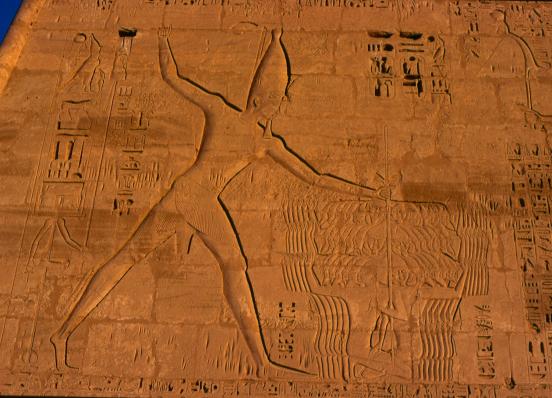Rameses III

Immediately after his father Setnakht died, Rameses III began a reign dedicated to slavishly copying the deeds of Rameses II, the builder of Madinat Habu temple. Rameses III evidently greatly admired almost everything about the reign of Rameses II. He adopted a similar titulary, gave his children the same names that Rameses II had given his, and modeled his Memorial Temple, Madinat Habu, on the Ramesseum.
Rameses III was an ambitious builder, and erected or added to scores of temples in Nubia, Egypt, and even western Asia. In his fifth regnal year, Egypt was faced with attempted invasions by Libyans on its western border, and by an eastern Mediterranean group known as the “Sea Peoples” on its north and east. Rameses III described how he defeated these armies on the walls of his temple at Madinat Habu. The lengthy and self-aggrandizing inscriptions and the accompanying huge, elaborately-detailed battle scenes were very similar to those used three decades earlier by Rameses II, and may have been copied from them.
The deeds of Rameses III were described in Papyrus Harris I, a contemporaneous account now in the British Museum. Papyrus Harris is over forty-one meters long, and its 117 columns of text detail the king’s donations to various Egyptian deities, lists the buildings, ships, estates, and land he donated to Thebes, and inventories the taxes collected during his reign. It then goes on to describe the towns of Lower and Middle Egypt and surveys the recent history of Egypt. It is also a text filled with self-praise. In spite of great military and construction activity, or perhaps in part because of it, Egypt’s economy began to weaken during the reign of Rameses III. Documents found at Dayr al Madinah tell of the government’s inability to pay workmen’s salaries and even acknowledge that workmen on royal projects went on strike for back wages. Texts also tell of court intrigue. One of Rameses III’s secondary wives, Tiy, plotted with several court officials to assassinate her husband and elevate her son, Pentwere, to the throne, ignoring the rightful heir, Rameses IV. But the plot was discovered, the culprits arrested, and the participants either killed or forced to commit suicide.
Rameses III buried the several children and wives who predeceased him in the Valley of the Queens. He himself was buried in KV 11, a tomb that had been begun by his father before he moved to KV 14. The remarkably well-preserved mummy of Rameses III was found in 1881 in the Dayr al Bahri cache.
